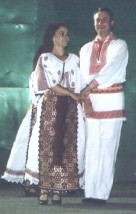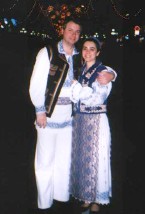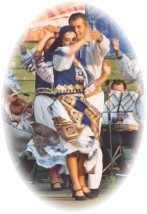|
Marius and Maria Ursu
|
|
CLICK AN IMAGE FOR LARGER VIEW
Marius Ursu is the master choreographer of the folk ensemble Doina Timisului of The Students' Culture House in Timișoara, Romania. Marius is mechanic engineer by profession, but he has decided to follow his goal in life, that of researching the Romanian dances and popular traditions.
 Marius was born in the countryside. He was familiar with the traditional life of the village and from this originates his love for music, dance, and costume. Throughout this period he visited and met the old men of the villages to enrich his knowledge about the rituals and customs of the Romanian countryside. This did not consist only of researching and transposing on stage the customs of the village, but also of facilitating and encouraging the reunion of the different rural groups and their participation at different folk festivals. From the age of 14, Marius began dancing in the Doina Cernei folk ensemble of Orsova.
Marius was born in the countryside. He was familiar with the traditional life of the village and from this originates his love for music, dance, and costume. Throughout this period he visited and met the old men of the villages to enrich his knowledge about the rituals and customs of the Romanian countryside. This did not consist only of researching and transposing on stage the customs of the village, but also of facilitating and encouraging the reunion of the different rural groups and their participation at different folk festivals. From the age of 14, Marius began dancing in the Doina Cernei folk ensemble of Orsova.
Since 1983, he has been part of the folk ensemble Doina Timisului of The Students' Culture House in Timișoara. Since 1986, he also has been a member of the folk ensemble Timisul.
As a dancer and soloist, Marius participated in two national folk festivals, winning first prize in 1985 and 1987.
In 1987 he was promoted to assistant choreographer at the folk ensemble Doina Timisului, and since 1990 has been involved with this ensemble, considered the best student folk ensemble in Romania. At that time, Marius was the youngest master choreographer in the country, recognized by the National Association of Folk Choreographers of Romania. Marius knows that traditional dancing has a distinct motivation, either a ritual or ceremonial occasion, that goes on at the festivals around the year or at the local religious festivals. His choreographies are not limited to the technical aspect of the dance; they try to recreate the authentic atmosphere around a particular event. His choreographies are grouped into 30 suites, and include the regions of Banat, Bihor, Fagaraș, Muntenia, Moldova, Nasaud, Oaș, and Oltenia.
He also participated in the 1995, 1996, 1997, 1998, 1999, and 2002 Student National Folk Festival.
In 2004, he started organizing a Romanian traditional folk workshop in Timișoara, Banat, Romania, during which they went in the midst of villagers to see the dances, the music, and the original costumes that have been maintained unaltered to this day.
He has taken part in performances and workshops in other countries, including Andorra, Austria, Belgium, Brazil, Bulgaria, Canada, Egypt, England, France, Germany, Holland, Hungary, Italy, Japan, Moldavia, Poland, Spain, Sweden, Switzerland, Yugoslavia, and the United States.
 Maria Ursu has been fond of folk dancing from an early age, going through all the stages to reach artistic performance, from the children and youth folk ensembles to the renowned amateur ensembles Timisul and Doina Timisului.
Maria Ursu has been fond of folk dancing from an early age, going through all the stages to reach artistic performance, from the children and youth folk ensembles to the renowned amateur ensembles Timisul and Doina Timisului.
Maria has followed the courses of The Polytechnic Institute of Timișoara and from 1990 has been a member of the folk ensemble Doina Timisului, where she met Marius, choreographer of the ensemble. The two of them married in 1991 and they have a baby girl, Patricia.
Since 2000, she has been helping Marius with the preparation of the department for young women of the ensemble. In 2004 she became responsible for the preparation of the folk ensemble for youth, Doina.
By teaching together, Marius and Maria offer a teaching to all workshop participants, making couple dancing more easily understood.
Each one of their program contains a variety of dances form all the folk regions of the country.
Dances Marius and Maria have taught include Alunelul de la Vaideieni, Ardeleana Baba Peleaga, Ardeleana cu patru parti, Ardeleana de la Rugi, Ardeleana de pe Valea Almăjului, Ardeleana in perechi, Ardeleana mazărica, Ardeleana pe picior, Ariciul, Baltă de la Ștorobăneasa, Baltareasca de la Goicea, Banul Mărăcine, Barbuncul, Bataia a doua ca la Seceani, Bătuta, Bataia intâi ca la Seceani, Bătuta de la Vorona, Bătuta moldovenească, Bătuta de la Tudora, Brâul bătrăn, Brâul borlovenilor, Brâul cârpenilor, Brâul ciclovenilor, Brâul de la Bozovici, Brâul de la Gornea, Brâul de la Marga, Brâul fetelor, Brâul fetelor de la Crihalma, Brâul hotilor, Brâul lui Boata, Brâul lui Boscai, Brâul lui Doica Fira, Brâul lui Ioșca, Brâul lui Marius Mihai, Brâul lui Muia, Brâul lui Murgu, Brâul lui Paica, Brâul lui Snop, Brâul lui Toma, Brâul Maranului, Brâul paduranesc, Brâul Semenicului, Brâul studentilor, Brâulețul de la Amărăsții de Jos, Bugeacul de la Plosca, Bugeacul de la Țiganești, Bugeacul de la Tencănău, Bobocica de la Cerăt, Boiereasca de la Ilovăț, Carabasiul, Ca la bălta de la Poiana Mare, Ciocanița, Cioful, Codranește, Corobeasca, Corăghește, Cotitŭ, Cucuruzul, Damul, De-a lungul, De doi - Cimpoiul, De doi - Frunză Brandului, De doi a lui Ioviță, De doi a lui Luță Ioviță, De doi a lui Pătrușcu, De doi cu fete - Triolet, De doi de la Ciuta, De doi de la Iaz, De doi roată ca la Glimboca, De di rupt, Dubă, Floricică, Fecioreste ca pe Valea Drăganului, Forme de soroc ca la Sinmihai, Galaonul, Galaonul de la Cerăt, Greaua, Hangul, Hațegana ca la Mediaș, Hațegana ca la Sibiu, Hora ca pe Valea Almăjului, Hora de la Focșani, Hora mare de la Peștișani, Hora mare, Hora mătăsii, Hora mică, Hora moroșanca, Iedera, Iciul, Întoarsă, Întoarsă ca la Seceani, Ițele, Invârtita lui Ion Macrea, Invârtita rara din Sălaj, Invârtite ca-n Năsăud, Judecată, Jumătatea ca la Seceani, Jiana lui Ioan Macrea, Litaidoiul, Mărunțel, Mereul de la Galicea Mare, Mocancuța, Momirul, Muiereasca de la Șeredei (Socăcițele), Muiereasca fetelor din Bihor, Ofitereasca de la Goicea, Pe loc a lui Iepta Lupu, Pe loc ca la Jebel, Pe loc ca la Lighed, Pe loc ca la Murava, Pe picior, Pe sub picior ca la Seceani, Poccinata ca la Seceani, Polca a doua, Polca intâia, Ponturi din câmpie, Posovaica pe un picior, Posovaica pe-amândouă, Roata feciorilor din Oaș, Rogojina, Rustemul bătut, Rustemul de la Lelești, Salta, Sârba de la Vrancea, Șarită in sus ca la Seceani, Sinaia de la Balești, Sitele de la Beiu, Sofreneasca, Sorocul de la Beregsău Mare, Sorocul de la Felbnac, Sorocul de la Jebel, Sorocul lui Bodroc, Sorocul lui Toni, Sorocul mare, Stearsa ca la Seceani, Susanul, Tarapanaua, Taltul ca la Seceani, Țărănească, Țărănească de la Voinești, Trandafirul din Bucovina, Trei pazește, Trilișesti, Tropotita din Oaș, Ursareasca, and Vulpea.
